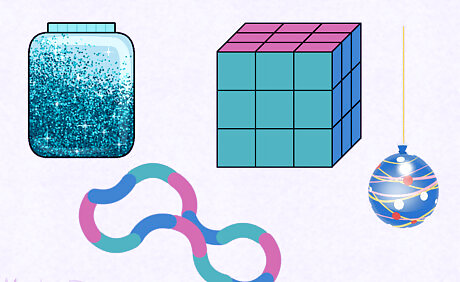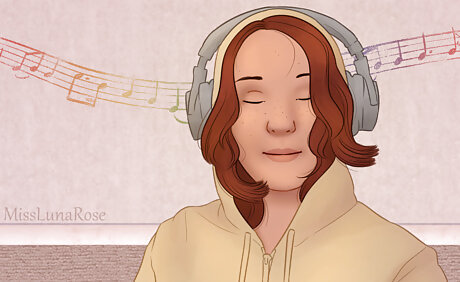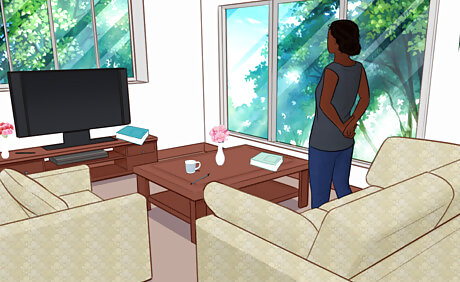
views
X
Research source
Repetitive, self-soothing behaviors can help people concentrate, communicate, and relax in heightened situations. But sometimes, these behaviors can cause people to stare. You are under no obligation to lessen your stims or Autism to make other people comfortable, but if stimming discreetly helps you feel comfortable, we’ve got just the trick. Keep reading to learn how you can stim discreetly in any situation.
What is stimming?
Stimming is short for self-stimulation, and is a common Autistic behavior. There are several ways a person can stim just as there are several reasons why someone may stim. If someone is feeling overstimulated, understimulated, or is self-soothing, they may flap their hands, hum, spin, or rock back and forth. The repetitive motion or act helps calm their nerves and feel more connected to their body. In other words, it helps them feel more in control in uncontrollable situations. Stimming can also be referred to as “stereotypy.” In some parts of the world, stims are known as ticks.
Ways to Stim Discreetly
Wear stimming jewelry. If you find yourself fidgeting when you’re bored or in stressful situations, fiddling with stim jewelry may help you stim without anyone noticing. The movement and textures of these pieces can satisfy sensory-seeking behavior and possibly help you focus. Stimming necklaces come in various textures and designs that you can chew, feel, rotate, and shake. Stimming bracelets have differently textured beads and strings that you can move and play with absentmindedly. Stimming earrings come with dangling pieces and rotating beads that can easily be tugged on. Stimming rings have a rotating outer plate you can flick discreetly with your thumb.
Apply lotion or lip balm. This is an alternative, discrete way of stimming that redirects your “fight or flight” to “rest and digest.” The act of putting on lotion or lip balm can calm your nervous system while appeasing the need to stim, making it great for any social situation. Use a scented lotion or balm that helps you feel calm, happy, and serene. Keep a small bottle of lotion or lip balm in your pocket or bag to pull out when you need to regroup.
Rub your thumb over a piece of cloth or eraser head. Sometimes, fidgeting can help you concentrate. If you’re studying, taking a test, or in a conversation and your mind starts to wander or you feel uneasy, moving something around in your hand may help. Try rubbing your shirt sleeve in your palm, gliding your thumb over a blanket, or tapping an eraser with your thumb. These can help you maintain focus while self-soothing. Try keeping an eraser or handkerchief in your pocket. This way, a stimming tool is within reach whenever and wherever.

Play with a fidget toy. When things get overwhelming, reach for a toy many won’t even take a second glance at. Nowadays, fidget toys are mainstream, making them easy to find and use in public. Consider tossing one of these toys in your bag or pocket the next time you go out: Fidget spinners Tangles Puffer balls Slinkies Putty
Move your tongue around in your mouth. Roll your tongue around in your mouth or make inaudible clicking noises. With your mouth closed, no one will be able to know what you’re doing!
Squeeze your hands together. Say you’re sitting in a loud classroom with flickering lights and need to stim to stay present. Try squeezing your hands together underneath the desk. This is a form of deep pressure stimulation and can help you self-soothe your nervous system when things get overwhelming. Try not to squeeze too hard—you shouldn’t feel pain when you’re stimming as it should be enjoyable.

Chew gum or suck on hard candy. When you chew gum or suck on candy, you’re naturally going to repeatedly move it around with your tongue, chew, or suck, making this the perfect self-regulating behavior. Plus, no one will think the wiser if you pop a piece of gum or mint into your mouth. Sucking on a lollipop is also an option. Keep a pack of your favorite gum or handful of hard candies in your bag. This way, you can reach for one whenever you need to concentrate or self-regulate—you could even offer one to a friend!
Play with the hem of your shirt. This is a discrete sensory-regulating behavior that cures boredom you can do just about anywhere with whatever you’re wearing. Pull down a shirt or coat sleeve to feel the fabric in your palm, or slide your hand into a pocket and twirl the lining in your fingers. If you’re wearing a jacket or hoodie with a drawstring, you can also try curling the string around your fingers.
Twirl your hair. Many people play with their hair around when they're bored, and whether they know it or not, this is a type of stim. This is a nice option if you have longer hair and can help you focus and self-soothe anxieties. Do your best to redirect your stim if you start pulling or tugging on your hair. This could turn into a self-harm stim and cause more stress than ease.
Tap your fingers. If things start to get too loud, whether in your head or the environment, try tapping your fingers on a desk, book, chair arm, or your leg. This can help you concentrate on something other than the noise. Gently tapping your foot can also help. Think of a song and tap to that beat or make up your own.

Listen to music. Enjoying the same song repeatedly is a very discreet stim. This repetitive behavior is a form of sensory-seeking and can help you feel more calm and self-aware. Pick a song you love, toss on some headphones, and let the music move through you. Add another stim like rocking, finger tapping, or humming to feel even happier—everyone will just think you’re enjoying the music, not stimming! This discreet stim is great for when you’re on a walk or in a crowd, but may not be best if you’re in class or attending a meeting.

Watch a video. Turn on a comforting movie, show, or clip to visually stim. No one will think twice if you’re simply watching something on your phone. Pick a video that makes you feel happy and safe, and play it over and over again. The video can also be something you put on in the background. When you need to focus, watch the screen for a few minutes. Use this discreet stim when you’re at home or even at a friend’s house, but it may be best to opt for something else if you’re in class or at work.
Type on a computer. Use repetitive typing motions to stim while working in class. If you’re using a computer to write an essay or finish an assignment, make a separate document designated to stimming. Type the same word, phrase, or sentence over and over again. This can help you concentrate, and the clicking sound of the keys can be quite satisfying. If you’re not using a computer, no worries! Try writing out the same word, phrase, or sentence repeatedly on a sheet of paper.
Knit or crochet. Handheld textile crafts are a socially acceptable sensory experience. The act of knitting or crocheting is naturally repetitive, making it the perfect way to stim and create. Holding the yarn and needles, feeling the textures, and seeing the colors aid sensory regulation. Plus, crafting new and unique pieces gives you a self of control in overwhelming or stressful situations. Pair this activity with another stim like listening to music or rocking back and forth. Knitting and crocheting in public may not be “discrete,” but it’s more socially accepted than other stims.
Tips for Social Situations
Communicate your needs to others beforehand. If you have a social event coming up, let others who are also attending know about your stimming, as long as you’re comfortable. Educating people on the importance of stimming can help them understand what to expect and be more accepting. Plus, it can give you peace of mind knowing those around you are aware. Try saying something like, “Hey! I just wanted to let you know that this party is going to be a little challenging for me. I might need to take breaks and leave early. If you see me acting a little strange or avoiding people, please know that everything’s okay. I’ll re-engage as soon as I feel well enough.”
See if you can modify the situation. Altering your schedule and thinking of alternative ways to handle a situation can help you adapt and feel more comfortable. Who knows? You may even be able remove the source of your worries. Consider modifying the situation in these four ways: Do things at less busy times. For example, go grocery shopping early in the morning or late at night rather than at the peak time. Opt for quieter places. If you’re taking a test, ask if you can complete it in a private room where you can stim freely. If you’re meeting a friend, see if they can meet in a less crowded area like a library or park. Look between someone’s eyes rather than at them. This can help if you’re anxious during face-to-face communication. Spend time with people who understand. Prioritizing relationships with those that care rather than judge will help you feel better about yourself—you don’t deserve to be judged for being you!
Get enough physical activity. If you’re a sensory-seeking fidgeter, exercising before a big social event can help reduce your need to stim. It may even help you feel more calm and energized. Try some of these activities before the situation: Running or walking around the block Jumping up and down in place or on a trampoline Dancing to your favorite music Swinging on a swing Spinning around in place or on a chair
Consider taking breaks. Schedule in time during a social situation to excuse yourself, find a quiet moment, and stim. This can help you regroup and feel more relaxed and energized. You don’t have to tell someone what you’re doing. Simply excuse yourself to use the restroom and do what you need to do. If you need a gentle reminder to take a break, set a vibrating alarm on your phone beforehand.
Schedule time to relax before and after the event. Giving yourself space to relax will help you recharge. Take the time to take a nap, read a book, watch a movie, or even listen to music before and after a social situation. You’re more liking to stim if you’re feeling distressed as the repetitive movement can help you calm down, so ease into social situations, if you can, to minimize public stimming. Use deep pressure stimulation to help yourself relax by covering yourself with a weighted blanket or wearing tight clothing.
Plan ways to reduce disruptive sensory input. If loud noises, bright lights, or strong scents make you uncomfortable, do what you need to do to feel more at ease. Here are some simple ways you can block out those pesky everyday triggers: Wear sunglasses to lessen harsh lights Wear earplugs or noise-canceling headphones for loud sounds Wear or diffuse essential oils that calm you to minimize strong scents
Consider if skipping the event is the way to go. Hiding or holding back your Autistic traits can be draining, and doing it too often could hurt your mental health. If an event or situation sounds like it’d be too much, don’t force yourself to go. Ultimately, do what’s best for you. Your health is what’s most important at the end of the day.


















Comments
0 comment